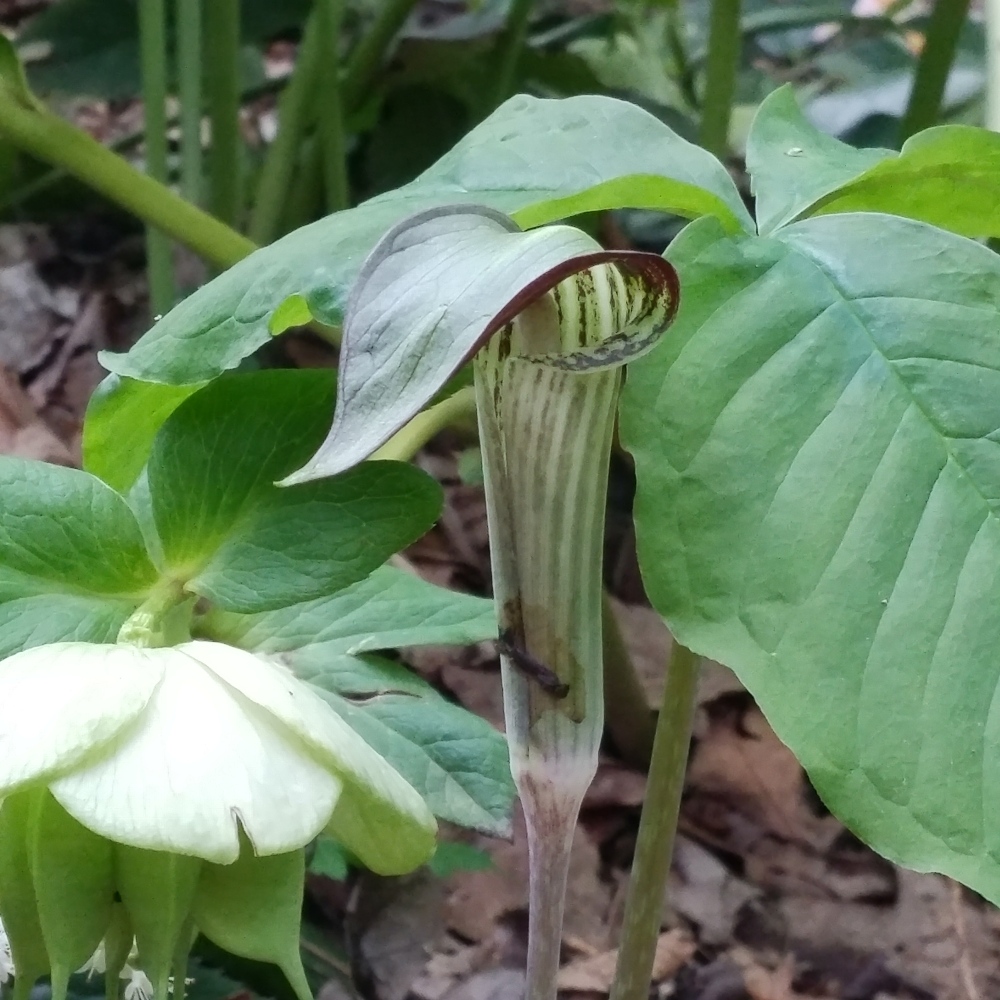Recently, I extolled the virtues of hellebores, and the profuse numbers of seedlings that require occasional thinning out, but also encourage sharing with other gardeners. Today, I’m pleased to report tiny seedlings that I am quite certain are from Jack-in-the-Pulpits (Arisaema triphyllum and others, below) planted in recent years. To protect the little treasures until they reach a stage where there are sufficient roots for transplant, I’ve dragged my wife over to show her the crevices between stones, to tell her not to pull seedlings that are not weeds as she relentlessly prunes and plucks to keep the garden’s paths clear.
 While hellebores can occupy several square feet of space once mature, Jack-in-the-Pulpits grow more upright and take up very little space. In this jumbled garden, plants are expected to grow up through, and to flop over one another, so this is not only allowed, but encouraged. For the gardener intent on neatness, plants that spread aggressively or seed prolifically should be discouraged, but not in this garden.
While hellebores can occupy several square feet of space once mature, Jack-in-the-Pulpits grow more upright and take up very little space. In this jumbled garden, plants are expected to grow up through, and to flop over one another, so this is not only allowed, but encouraged. For the gardener intent on neatness, plants that spread aggressively or seed prolifically should be discouraged, but not in this garden.

I am delighted that the variegated Solomon’s Seals (Polygonatum odoratum var. pluriflorum ‘Variegatum’, below) have spread more than expected this spring. I’m not certain how these could possibly fit into a more formal garden, but there’s no formality here, and I’m intrigued to try other cultivars that look interesting in photos. Some can grow quite large, it appears, and these interest me in particular. Oddities such as these attract the gardener to specialty nurseries, many operated by plant explorers who have found these on some faraway mountain, and who could care less if there’s any commercial appeal to their finds.

Native wood poppies (Stylophorum diphyllum, below) have continued to spread in the dry shade beneath towering maples and tulip poplars, with new plants appearing scattered by twenty paces. I’m uncertain how these manage to find their way uphill, but I’ve no complaint and if one should appear where it’s not wanted I suspect these are easily removed. While the flowers are short lived, the mounding foliage is interesting enough. These give the appearance of being well placed by the gardener in small areas of open ground, but their placement is purely a matter of natural opportunity. While wood poppies are ideally planted in damper soil, I suspect that maple and poplar leaves left to decay have greatly improved the top layer of soil in this area.

Certainly, Robb’s or Wood spurge (Euphorbia amygdaloides var. robbiae) is likely to be considered a weed by some, but I am continually impressed that it surges ahead through dense, shallow roots to cover open ground. No doubt, some would consider this too aggressive, but in moderately dense, and undoubtedly dry shade, it has spread to cover a few hundred square feet, though it carefully winds around clumps of ferns and plum yews. On occasion when a stem appears between stones in the path, or elsewhere where it’s not wanted, these are easily snatched out.
Cypress spurge (Euphorbia cyparissias, below) is reviled as invasive, but planted alongside a stone patio by the koi pond it has been pushed to the side by seedlings of Espresso geranium (Geranium maculatum ‘Espresso’). Probably, no gardener would curse a lovely native such as the geranium, but this shows the relative nature of invasiveness. Here, the spurge is the victim, geranium the bully, and happily I transplanted a few small clumps several years ago or it could have been run out of the garden.

